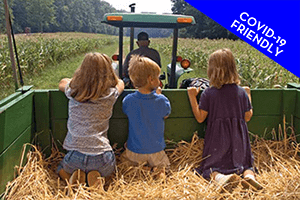AUGUST 2017
 Allowing people to visit your farm provides a unique opportunity for you to tell the story of your farm and to teach visitors about agriculture.
Allowing people to visit your farm provides a unique opportunity for you to tell the story of your farm and to teach visitors about agriculture.
Agritourism can also be a great way to increase farm income, but the additional risks and responsibilities must be considered.
SAFETY CHECKLIST
The checklist below lists a few ways you can be prepared for visitors on your farm and keep them safe:
- Does the farm have three distinct areas: non-animal areas, animal areas, and entrance/exit transitions between? Are the number of people visiting animals kept to a minimum? If possible, create a way for people to view livestock from the safety of their vehicles.
- Do visitors from different households stay at least 6 ft apart?
- If food is available, do people eat and drink first, then visit the animals?
- Does the farm have handwashing stations, including running water, soap, and paper towels?
- Are the hand washing facilities accessible for children and those with disabilities and located conveniently next to both the animal areas and food?
- Are signs visible throughout the venue reminding people to wash their hands and avoid hand-to-mouth activities?
- Are the animals safely contained in pens?
- Are visitors restricted from entering pens?
- Have you restricted all physical contact of chicks, ducklings, reptiles, and calves?
- Is there a plan in place to clean surfaces with disinfectant, especially frequently-touched surfaces, between visitors?
- Is there a plan to remove sick animals from public contact?
- Are all farm workers or hired staff trained in the national best practices for animal contact?
You and/or your employee(s) can download and print a pdf checklist to complete safety checks on your farm. Keep the completed forms for follow-up, future reference and inspections.
DOWNLOAD PDF CHECKLIST
Disclaimer: The facts and information listed above are suggestions for your safety, but are in no way a comprehensive and exhaustive list of all actions needed to ensure your safety.

